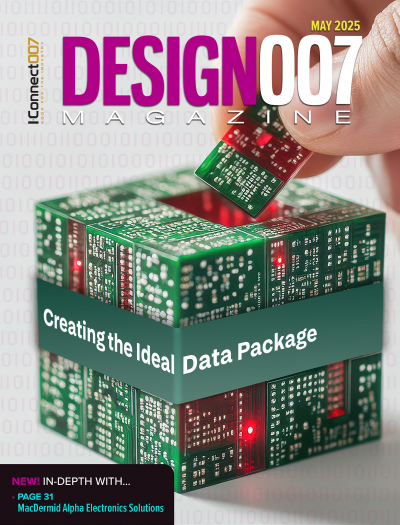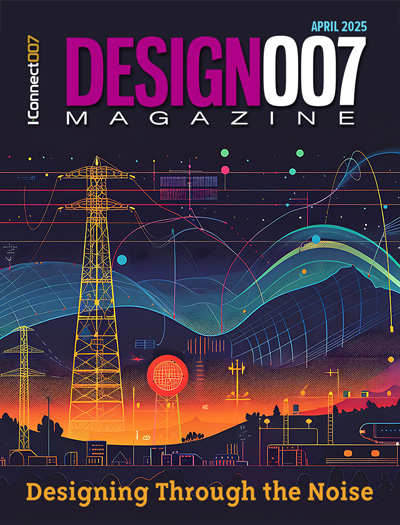-

- News
- Books
Featured Books
- design007 Magazine
Latest Issues
Current Issue
All About That Route
Most designers favor manual routing, but today's interactive autorouters may be changing designers' minds by allowing users more direct control. In this issue, our expert contributors discuss a variety of manual and autorouting strategies.

Creating the Ideal Data Package
Why is it so difficult to create the ideal data package? Many of these simple errors can be alleviated by paying attention to detail—and knowing what issues to look out for. So, this month, our experts weigh in on the best practices for creating the ideal design data package for your design.

Designing Through the Noise
Our experts discuss the constantly evolving world of RF design, including the many tradeoffs, material considerations, and design tips and techniques that designers and design engineers need to know to succeed in this high-frequency realm.
- Articles
- Columns
- Links
- Media kit
||| MENU - design007 Magazine
RF PCB Design Tips and Tricks
May 8, 2025 | Cherie Litson, EPTAC MIT CID/CID+Estimated reading time: 1 minute
There are many great books, videos, and information online about designing PCBs for RF circuits. A few of my favorite RF sources are Hans Rosenberg, Stephen Chavez, and Rick Hartley, but there are many more. These PCB design engineers have a very good perspective on what it takes to take an RF design from schematic concept to PCB layout.
Here’s a quick summary of the common suggestions that I’ve learned from them and others over time:
- A schematic shows the “ideal” functionality of the RF circuit. When creating a schematic in the PCB layout, the “real” physics of the copper strips, dielectric material, and adjacent circuits and metal features create parasitic influences: resistance, inductance, and capacitance.
- It is the responsibility of the layout engineer to minimize the differences between the “ideal” and “real.”
- Electronic devices and systems operate at frequencies ranging from a few megahertz to several gigahertz. Finding the best method to control the parasitic influences requires only a few basic guidelines.
- Identify and understand the current loops in the circuit
- The shorter the loop, the lower the impedance and resistance ratios
- Use an uninterrupted ground plane as close as possible to the referenced signal
- Give each ground connection its own via as close as possible to the pad
To do this in a PCB, remember it is a 3D environment. Uninterrupted ground plane layers close to their signal, impedance calculations, material selection, copper thicknesses, trace thicknesses, shielding, and spacing become the tools to control the parasitic influences of the “real” circuit.
Methods for applying each of these tools in your PCB design are available for all designers. Then download a tool such as Saturn’s free PCB Toolkit and see how switching to different parameters in the “differential pairs/XTALK” tab will change the values of your target impedances. This will get you in the ballpark of creating a good RF design.
To continue reading this article, which originally appeared in the April 2025 issue of Design007 Magazine, click here.
Suggested Items
Results of the AT&S Annual General Meeting: Andy Mattes appointed Chairman of the Supervisory Board
07/04/2025 | AT&SAndy Mattes was newly elected to the Supervisory Board of AT&S Austria Technologie und Systemtechnik Aktiengesellschaft and is appointed until the 36th Annual General Meeting 2030. Georg Hansis was re-elected.
Murray Percival Company Welcomes CeTaQ to Its Line Card, Optimizing SMT Processes for PCB Manufacturers
07/03/2025 | Murray Percival CompanyThe Murray Percival Company, a trusted supplier to the Midwest's electronics industry, is pleased to announce that it has added CeTaQ to its line card, a global expert in Surface Mount Technology (SMT) measurement systems.
Why I Finally Embraced Autorouting
07/03/2025 | Stephen V. Chavez, Siemens EDAHere is a common misconception held by those who don’t fully understand the PCB layout process or how to wield today’s high-level EDA tools: "All I need to do is push the autorouter button, let the computer route all the signal traces, and get the layout 100% routed. It’s a no-brainer. Anyone can do it. It should take less than a few hours.”
China Plus One, Part 3: Inorsen Group, a Vietnam Success Story
07/03/2025 | Manfred Huschka, Manfred Huschka Management Consulting (Shenzhen) Ltd.In recent years, Western OEMs have continued to push for China Plus One factories and the advancement of China’s Belt and Road Initiative (BRI). At present, there are two main modes for PCB companies to go global: building greenfield factories or through mergers and acquisitions (M&A). Thailand is currently the primary geographic choice to build greenfield factories, whereas, increasingly, mergers and acquisitions in Vietnam and Malaysia provide opportunities for companies to expand markets and acquire resources.
Symposium Review: Qnity, DuPont, and Insulectro Forge Ahead with Advanced Materials
07/02/2025 | Barb Hockaday, I-Connect007In a dynamic and informative Innovation Symposium hosted live and on Zoom on June 25, 2025, representatives from Qnity (formerly DuPont Electronics), DuPont, and Insulectro discussed the evolving landscape of flexible circuit materials. From strategic corporate changes to cutting-edge polymer films, the session offered deep insight into design challenges, reliability, and next-gen solutions shaping the electronics industry.


